According to data from the World Health Organization, every second on earth every year someone is infected with a worm. Many people think that parasites are not very harmful to health. However, not everything is that simple: worms can infect important internal organs: the heart, lungs, and brain.
Worms-who are they?
Worms are parasitic worms that can choose human, animal, and plant bodies as their hosts. There are three types of worms:
- insect.This category includes approximately 3, 500 species of worms. The length of parasitic worms varies from a few millimeters to 10-15 meters.
- kes.Parasites get their name because they have suckers, which can absorb nutrients. The human body can be infected with about four dozen species of trematodes. Generally, the length of the worm does not exceed 5 cm.
- Round worm.There are more than 24, 000 species of such worms. The worm is fusiform. Generally, their length does not exceed 0. 5 meters.
You can infect worms in various ways. However, the most common parasite invasion is due to the following reasons:
- Poor hand hygiene.
- Unwashed vegetables, fruits; undercooked or undercooked meat, fish-the use of such products can increase the risk of parasite infestation many times.
- Put food outside the refrigerator. Insects can transfer worm eggs to food that can be stored without packaging.
- Contact with pets.

The main symptoms of internal parasites:
- Nausea, vomiting, diarrhea;
- lose weight;
- Allergic rash;
- Bloating
- Itchy anus;
- Grinding teeth in a dream.
What are the most common worms in Russia? Consider the most common types of parasitic worms and the diseases they cause.
worm
The tapeworm's body is made up of members, from 3 to 5000 in total. The main element to fix the worm is the head, the others are suckers and hooks.
The most common causes of tape bugs are:
- Biloba flagellosis;
- Tenascin
- Tenosynovitis.
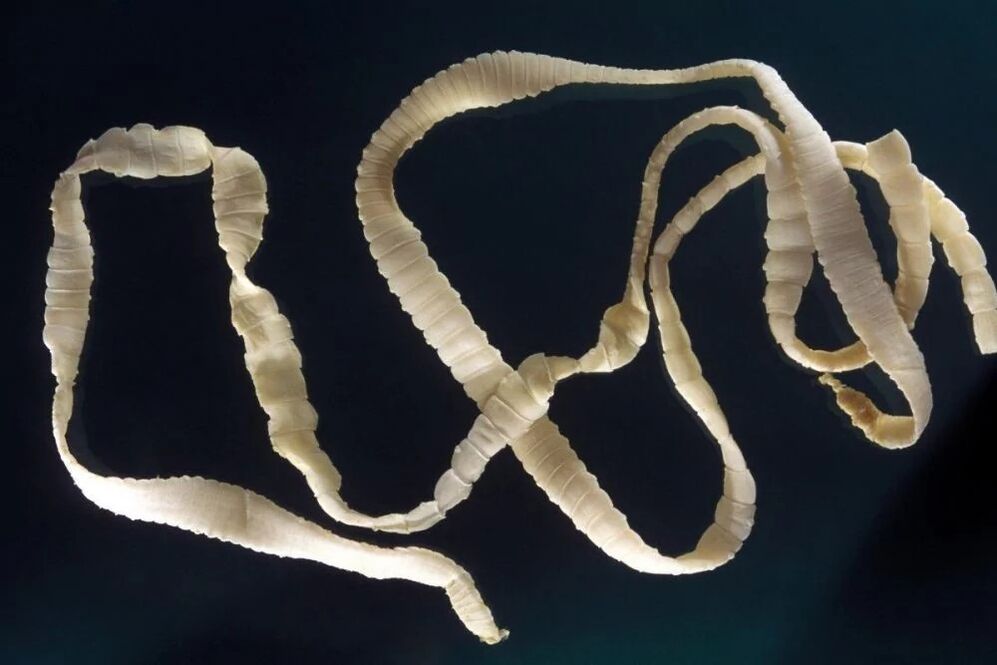
Biflagellate
The pathogen of the disease is a wide range of tapeworms that affect the human intestines. The development of worm eggs occurs in fresh water. The program for the insect to enter the human body is as follows:
- The eggs of the worm are swallowed by the crustaceans living in the reservoir.
- The infected crustaceans were eaten by fish.
- Eating fish that have not been sufficiently heat treated can infect parasites.
The symptoms of the disease develop 1. 5 months after infection. The main sign of pathology is the presence of worm fragments in the stool.
The tapeworm attaches to the intestinal mucosa and absorbs a large amount of vitamin B12. For this reason, people with biloba flagellosis often suffer from anemia. In addition, the worm can cause liver, spleen, and intestinal obstruction.
Teniarinhoz
The pathogen of the disease is bovine tapeworm, which mainly lives in the human small intestine. In its development cycle, the worm replaced two hosts: cattle in the middle, mainly humans. Cow tapeworm can live in the body for 20 years, reproduce and endanger health.
Generally, people develop taurine after eating undercooked or undercooked beef.
The disease usually progresses without obvious symptoms, and when a person sees the worm element in the stool, the disease is discovered by accident. In some people, in addition to the main signs of worm infection, the pain syndrome may also occur on the right side of the anterior abdominal wall.
Adult worms can penetrate the appendix, pancreatic duct, and biliary tract, causing their acute inflammatory process. Along with a variety of parasitic infestations, intestinal obstruction may occur.
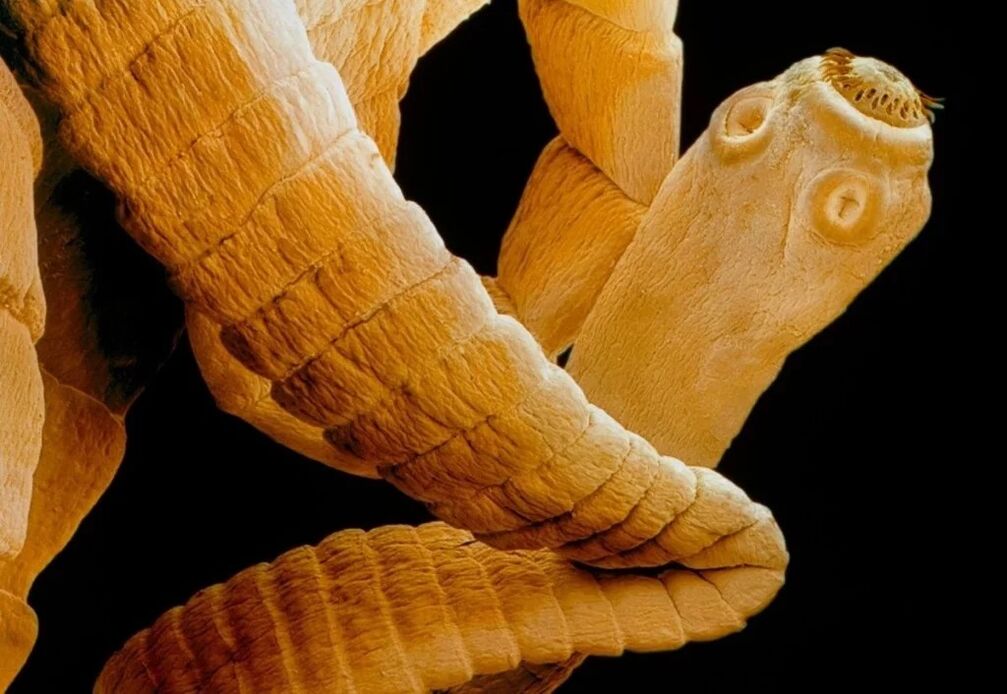
Tenosynovia
The pathogen of the disease is pork tapeworm, which initially infects the human small intestine. Eating raw or undercooked pork can cause human infections.
Parasites can infiltrate various organs and tissues, causing pain in the abdomen, back, and limbs. Pathology is most beneficial when worms are located in subcutaneous fat and skeletal muscle tissue. When worms penetrate the eye muscles, they can cause vision loss, tearing, and photophobia. Destroying the pork chain of the brain can be fatal.
Sucker
The scales are leaf-shaped and have high reproductive capacity during different periods of the life cycle. The reproduction of worms can be done not only in a sexual way, but also not. In addition to suckers, worms also have many hooks and spines, so they can reliably attach to the mucous membranes of organs.

Common pathologies caused by flukes:
- Fascial disease;
- Aspirin schistosomiasis;
- Paragonimiasis.
Fascial Disease
Fascioporosis occurs when the liver or gallbladder is damaged by liver flukes. Basically, infection occurs when eating vegetables, because vegetables are irrigated with water from open reservoirs.
In addition to the standard symptoms of parasitic infection, a person may also suffer from an asthma attack with shortness of breath, facial flushing, dilated pupils, and tachycardia. If an adult causes obstruction of the bile duct, obstructive jaundice occurs. Pathological signs:
- Right subchondral colic;
- Yellowing of the skin;
- fever;
- Colorless stool.
Pneumothorax
The causative agent of the disease is cat fluke. The name of the parasite is due to the fact that in addition to humans, it also infects cats and other mammals that eat fish.
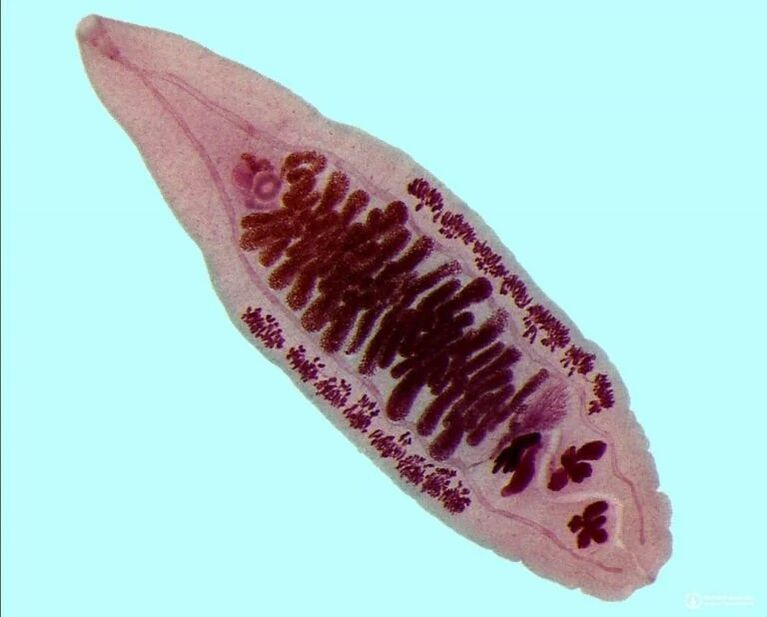
Usually, cat flukes infect the liver and pancreas, causing inflammation of the organs. The symptoms are varied, depending on the number of parasites. Patients may experience:
- Symptoms of poisoning;
- fever;
- measles;
- Itchy skin;
- Muscles, joints, and right subchondral pain.
In some cases, worms can cause an increase in lymph nodes and the development of jaundice. Chronic pathological forms usually lead to hepatitis and cirrhosis.
Paragonimiasis
The culprit of the disease is lung fluke, which infects crustaceans and enters the human body.
First, the parasite enters the human intestine, and then enters the abdominal cavity. The end of his journey is the lung tissue. In addition, worms can penetrate the brain and affect the central nervous system.
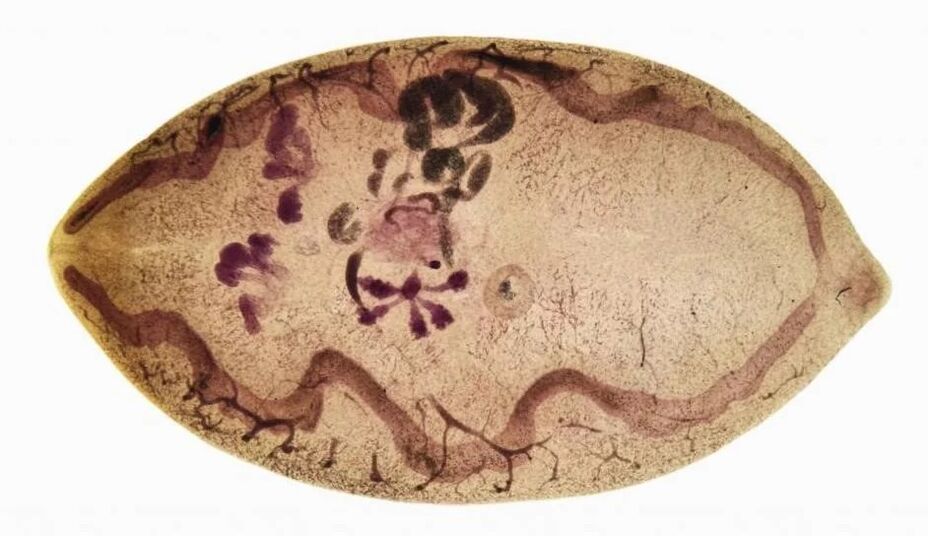
Specific signs of parasite invasion in the lungs:
- Chest pain
- Cough with sputum, which may contain pus and blood.
- fever.
In some cases, worms can invade the respiratory function of the lungs and exchange gas during breathing.
Roundworm
Due to its structure, roundworms (nematodes) can survive even under extreme conditions. Their body is covered by a three-layer muscle skin sac, which can reliably protect parasites from external influences.
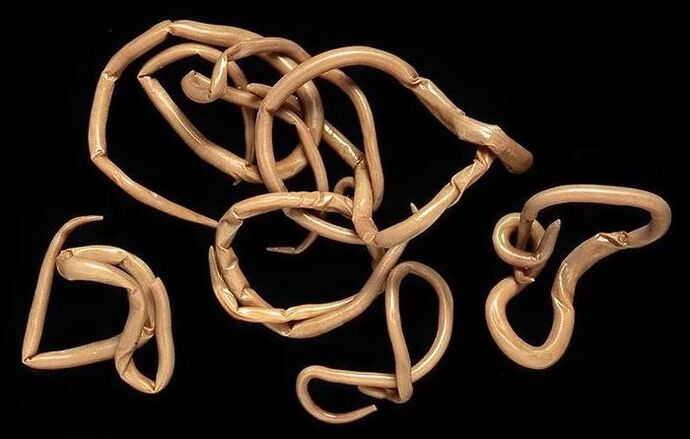
Common diseases caused by nematodes:
- c insect disease;
- Entero-intestinal disease
- Trichinosis.
Insects
The development of this disease can cause worm disease, which is initially fixed in the small intestine. The average length of an adult is 40 cm. The larvae of the parasite enter the human digestive system with unwashed vegetables and fruits and contaminated water. In addition, poor hand washing before eating is usually the cause of worm disease.
As the larva enters the human body, the temperature of fever, allergic rash and cough can be observed accompanied by the release of transparent sputum. Only in the presence of several parasites can the signs of the intestinal stage of asparasites (diarrhea, abdominal pain) be observed. Usually, living in the intestine of a worm is asymptomatic.
Complications of various parasitic infections:
- Bile duct obstruction;
- The gallbladder, the purulent inflammatory process of the liver;
- Inflammation of the appendix;
- intestinal obstruction.
Intestinal biasis
The provocateur of the disease is the pinworm-a small worm up to 1 cm long. The worm penetrates the human digestive system like the round worm.
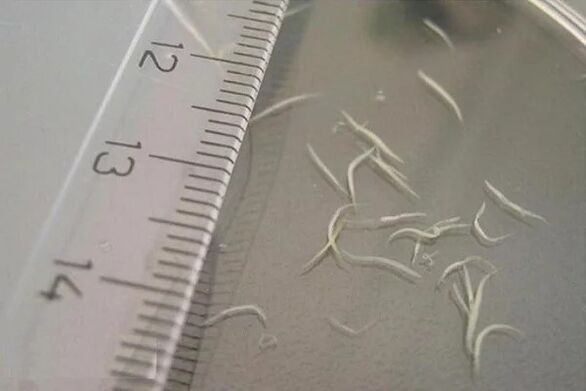
At present, intestinal helminthiasis is the most common parasitic disease in the world. Basically, this disease is diagnosed in children under 10 years of age.
As in the previous situation, the symptoms only appear under the infestation of a variety of parasites. Children often experience diarrhea, mucus in stool, difficulty and pain in digestion, itching and nausea in the anus. If the condition is severe, limb cramps may occur. In addition, pinworms can penetrate the genitals, causing them to acute inflammation.
Trichinosis
This disease causes Trichinella spiralis-one of the smallest parasites. The length of the parasite rarely exceeds 4 mm. In the larval stage, worms infect skeletal muscles. Except for myocardium-the muscular tissue of the heart. Adult parasitic small intestine.
Usually, eating half-raw pork can infect humans. At the same time, for the development of this disease, only 30 g of meat affected by parasites is sufficient.
The pathological manifestations are standard symptoms of parasite invasion. In the later stages, swelling of the eyelids, face, arms and legs, lower back pain, and chewing muscles may occur. Possible complications are complete or partial loss of mobility and airway paralysis.
How to avoid worm infection?
In order to reduce the risk of infection with parasites, please follow these guidelines:
- Wash your hands thoroughly before eating, shopping, or in public places.
- Observe the correct technique for cooking meat and fish. The heat treatment of meat and fish products should last at least 20 minutes.
- Don't eat dried fish or dried fish.
- Deworm your pets.
- Even if there are no pathological signs, check up regularly. The most common diagnostic methods are naked eye and naked eye examination. The first method allows you to detect adults, and the second method-to detect eggs and larvae of worms.

























